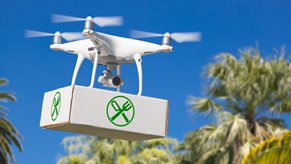Hygiene and cleaning

Linda: Hi, I'm Dr. Linda Gordon, safefood's Chief Specialist in Food Science. safefood is the all-island body responsible for promoting food safety and healthy eating. This is the Food Safety podcast series, where we look at the factors that shape the food industry on the island of Ireland.
This episode looks at hygiene and cleaning in food businesses and asks why it is so important that businesses take this seriously. Joining us is Ed O'Neill from Teagasc, who is an expert in art design and specialty foods. Ed has been involved in the development of a range of award-winning food products, including cheese, frozen desserts, salsas, and beverages. Thanks Ed for joining us.
Ed: Thank you, Linda, nice to be here.
Linda: I mentioned at the start that cleaning and hygiene is really important in a food premises, can you explain to us why?
Ed: Food premises need to be cleaned continually in order to eliminate the possibility of the growth or contamination by pathogenic, which are disease causing, bacterium, and spoilage microorganisms. In general, good housekeeping will help to maintain a clean and tidy workplace so that safe and wholesome food can be produced on a continuing basis. However, a clean premises requires a commitment to hygiene from all members of staff. It is, therefore, essential that all staff are made aware of how the cleaning program works and what each individual's duties are.
Food residues provide an environment where microorganisms can grow, and they must be eliminated. To reduce the risk of food spoilage and food poisoning, to allow for the disinfection of equipment and work surfaces, to reduce the risk of contamination by foreign matter, to provide a safe working environment, and to promote a good and well-run image to the consumers, which are very important.
Linda: So, what are the legal obligations then, with regard to cleaning, what are companies actually required to do?
Ed: The law states that every person working in a food handling area must maintain a high degree of personal cleanliness, and is obliged to wear suitable clean protective clothing, and the clothing is designed to keep you away from the food, not to stop the food spoiling your new shirt or nice tie.
No person suffering from, or being a carrier of disease likely to be transmitted through food, for example, with infected wounds, skin infections, sores, and so forth, is permitted to work or handle food in the food producing or food manufacturing environment. Any person so infected employed who's likely to come into contact with food should report immediately the illness or symptoms, and the possible causes to the FBO or the food business operator.
EU law clearly states that the principal objective of the new general and specific hygiene rules is to ensure a high level of consumer protection with regard to food safety. This requires an integrated approach to ensure food safety for the place of primary production in the factory, up to and including of placing the food product on the market, be it at home or be it abroad. Every food business operator along the food chain should ensure that food safety is never compromised.
Linda: But surely, it's not that complicated, Ed. I mean, make sure that the premises looks clean and everything will be well.
Ed: Well, I wish that were the case, but unfortunately it's not. Giving a table a wipe with a cloth is not cleaning. Remember, we are trying to eliminate potentially disease-causing bacteria, and other micro-organisms. In order to do this we must define a clear and ordered cleaning regime within the premises.
Linda: So, in order to develop this regime, what do food businesses need to consider in relation to their food, their specific food product?
Ed: Well, foods can be complex, containing lots of products, such as fats and sugars, proteins, salts and so forth, and other organic material. It can be difficult to remove these from surfaces and food production plants, but we need to understand the role of what various cleaning chemicals do, and in what order they're used.
safefood has developed a number of excellent workshops and short videos to assist food producers in understanding cleaning. Exposed foods should, first of all, be covered and stored to avoid any potential contamination from cleaning chemicals within the plant. Gross debris, bits of food and so-forth, traces of milk, et cetera, should be removed firstly. Cleaning should take place with a suitable detergent, taking note of the correct temperature and contact times, rinsing with portable water, and then disinfection using chemicals or hot water for a specific time and a specific temperature, and finally then, a finer rinse with potable water, and that should ensure that you're following a defined and clear regime inside your premises.
Linda: You mentioned the makeup of the product and the different components in it, so what are the factors to consider when you're thinking specifically if you've got a product that's very much protein based, or if you've got fats or starches that you're trying to remove?
Organic soil, usually from food, and it's typically fat and proteins, starches, they're extremely complex and difficult to remove. They may take the form of simple raw debris, such as milk, or more complex compounds, such as cooked or burnt on deposits, depending on what food product you're producing. It's very, very important, then, that you tailor-make the detergents and the chemicals used to remove these to the specific food product.
Linda: And, what about biofilms, and we hear about these and how they can form on food on surfaces in food businesses. Can you tell us a bit more about them, and more importantly, how we can remove them?
Ed: Biofilms are a very difficult subject to approach because you can't see them, you can't see them. They're down at the microscopic level. They're complex, very, very complex films. They result over time from improper cleaning, either through inadequate detergent use, or lack of heat during the cleaning cycle. This results in bacteria not being removed or not being killed. Some of these bacteria, in turn, can produce a polysaccharide, which is a sugar-type film called a biofilm, and that protects the bacteria and other microorganisms inside.
The protection of the film allows bacteria to grow and multiply, resulting in contamination and possible food safety risks. It also gives rise to peaks and troughs in the food environment, so sometimes you can have a blip in terms of spoilage organisms. Very, very difficult to explain, and a lot of the times it's down to biofilm formation, but if you're cleaning initially with the proper detergent, the proper temperatures and so forth, and using mechanical action, be it elbow grease or whatever else, this shouldn't exist.
Linda: Okay, so prevention is better than cure, then, when it comes to biofilms.
Ed: Indeed.
Linda: In terms of cleaning agents, then, what are the main types of cleaning agents that you would use or that you would recommend that businesses would use?
Ed: As a group, there's water, detergents, acids, and sanitizers. Alkaloid detergents, they usually have a pH value between eight and 14, so that makes them very alkaline. So, a combination of chemicals, such as sodium, potassium hydroxide, and they usually have surfactants added. These are surface active agents.
Blends of chemicals are much more effective. They are more expensive, but much more effective than individual chemicals on their own. Surfactants, your ordinary detergent at home, your Fairy Liquid or similar, is a surfactant.
Commercially, we use products like Tween-90, and they improve the wetting power, they allow the detergent to get in and to wet the actual debris or the soil, and by allowing the water to penetrate the soil more easily and they give greater cleaning abilities. They also help to keep the soil in suspension, so that when you're washing, it's not getting redeposited, it's not getting streaked and so forth.
There's also products called chelating compounds, and these help the removal of organic salts, they grab onto hard water oils, and they're removed then during the cleaning cycle. Chlorinated alkaline is very, very important for removal of protein. Protein is much more difficult to remove, especially if it's burnt on, and the chlorine version of detergents, or alkaline detergents, will remove these protein materials.
Acid detergents, then, are used, pH between zero and six. They, again, have additives added to make them more effective and so forth, but you should remember, with chemicals on your premises, they are indeed chemicals, and acid detergents should be prevented from coming into contact with chlorinated alkaline detergents. It may result in the liberation of chlorine gas, and it should never ever be mixed, so you have to be very, very careful as to how you store your chemicals, how we use them, and how they are applied on the actual factory floor.
Linda: Okay, so there's a lot to consider there.
Ed: Yes, there is indeed.
Linda: Apart from the type of cleaning agent, what other factors can impact on the effectiveness of the cleaning?
Ed: Effective cleaning is down to time, temperature, the concentration of your detergent, and the chemical action. Different methods of application will use a balance of these factors to give the required result.
Hand cleaning of removable parts needs a high degree of mechanical energy, lots of elbow grease, and the detergent strength and temperature use are limited by the associated risk to the actual workers, so in other words, if I am hand washing removable parts, the water is usually about 55 degrees and the detergent concentration is somewhere around 1 to 2%, and then you use a brush and so forth to clean these parts. If the water was very, very hot, such as 70 degrees, splashes can result in burns and so forth, so you wouldn't encourage that.
Cleaning in place uses a closed circulation system where high temperatures in excess of 60 degrees and chemical concentrations can be used over a much shorter period of time with little or no risk to any workers involved. Soak tanks, then, are commonly used for removable parts. Mechanical action is almost nil, but strong chemical concentrations can be used, so you can store removable parts overnight in soak tanks using parasitic acid, using chlorine, using iodoform and so forth to kill any surface active bacteria who may be there.
Foam is also used in the cleaning industry, frequently used on large surface areas, and the bubbles in the foam cause mechanical action, and that helps to break down any traces of debris on product surfaces. Foaming is only used on the exterior of tanks, food equipment, on walls, floors, and ceilings and so forth. And again, the action within pipe work and so forth, the flow of the actual cleaning solution is very, very important to maintain its action during its working time.
Linda:What are the different steps then in terms of the whole cleaning process, and if you've ever tried to break it down for people?
Ed: If we keep time, temperature, concentration, and action in mind, you first of all start off with rinsing. This is where gross debris is removed and washed to the floor or to a holding tank. Cleaning then, this is where detergent at the correct concentration and correct temperature is used to wash down equipment, or is circulated inline. You rinse then when the detergent is washed away to ensure that there's no residues still in your tanks and lines and so forth, and then you sanitize with a chemical that can be sprayed on or circulated inline to ensure the destruction of any microorganisms that might be left. You then rinse using some hot water to remove any traces of sanitizer present and so forth. There are a number of key points, clean surfaces are necessary to ensure satisfactory disinfection. So, disinfection must be proceeded by detergent cleaning.
Facilities and equipment must be adequate to do the job effectively, so if your equipment is not suitable for the job at hand, it might prove to be very, very difficult to clean, and might result in cross-contamination.
The actual efficacy of the detergents and the chemicals used is very, very important, as is the time and the temperature. Each disinfectant has its own unique properties, and protocols must be in place for all of these activities.
Chemicals must be used and stored safely, and combination of detergent sanitizers, as opposed to separate chemicals, will save time and will save money also. You should also keep the number of chemicals in use to a minimum to avoid confusion. What also works very, very well in some environments, especially the smaller units, is that some companies have color coded detergents and sanitizers. So, you might have blue for a removal of grease, you might have green for sanitizing, and so forth. Never ever mix chemicals. They may become neutralized, or worse still, they may become toxic.
Linda: In terms of putting together a cleaning schedule then, what information should food businesses include in this?
Ed:The cleaning schedule needs to be exact and easy to follow for any individual, so whether it's you, Linda, or myself who are responsible for cleaning on the day, we should have a clear set of instructions that are easy to follow and easy to carry out, and it's important that these schedules are carried out the same way every day in the same fashion. The detergent concentration, the sanitizer concentration, and the correct temperature are used at all times and for the correct length of time. Simple procedures like that, without making them overly complicated, will result in a clean and hygienic environment.
Linda: So, in your experience, Ed, of going around visiting different food businesses and advising them, what are the most common mistakes that people make when it comes to cleaning?
Ed: Cutting corners. Thinking that a good clean on Friday or Saturday will work for the entire week, so if I'm cleaning on Saturday, I don't need to clean Monday, Tuesday, Wednesday, Thursday, et cetera, et cetera.
Not understanding the role of cleaning and the proper use of cleaning agents is absolutely huge. The number of factories that we go to, and we ask them, "What are you using?" They give me a commercial name. They actually don't know the chemical inside. They don't know whether they're using a detergent or a sanitizer or an acid cleaner or whatever, and this is huge and common throughout the industry.
What's also very, very common is cleaning chemicals can be expensive, so a lot of companies then reduce the chemical use to save money, and in actual fact, they are doing more harm than good because the effectiveness is not there, it doesn't have the kill on these disease causing microorganisms, and you can have problems down the line. We did come across a company using high pressure hoses to simply clean what could be done by you or me in 10 minutes, cleaning belts, transition tanks, and so forth. They were causing huge aerosol spray from the floor, from the drains. This spray drifted down to the far end of the factory, landing on product produced that morning, causing contamination. So, these are the type of things, as I said, we come across everyday.
Linda: So, it's very easy to get it wrong if you haven't thought through exactly what you're doing and why you're doing it.
Ed: Absolutely.
Linda: So finally, if we've put all your advice into practice, how do we know that our cleaning has actually been effective?
Ed: The proof is in the pudding. In my experience, these companies that see the need for a clean regime and understand the cleaning processes will also understand that this not only contributes to the production of safe food, but these practices also impact on food quality. A good quality food product will be produced time and time again, leads into customer satisfaction and repeat business. And, my advice would be to get it right first time every time.
Linda: Okay, so on that note, we'll end it there. I'm Linda Gordon, and I'd like to thank my guest, Ed O'Neill for joining us and giving us such a clear insight into the importance of cleaning and hygiene in a food premises. Thanks to you, our listeners, for tuning in. Please, spread the word about the safefood podcast series to anyone you think could benefit from us. If you want to hear more on this or other food safety or nutrition issues, search safefood Podcast, or join the conversation on @safefoodnetwork and follow us on LinkedIn. Until the next time, goodbye and take care.



